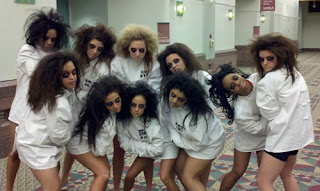An anonymous poster alerted me to Chicago’s Robert Morris University dance team and their recent 8th place finish in a dance competition. Their costumes? You guessed it. Straight jackets. (Update 3/14/11: here’s the cached version of the story and picture, as it has dissappeared from the live site)
I can’t believe we’re seeing this again, particularly so close on the heels of the fallout from the Waunakee High School dance team performing a similar routine. RMU Dance Team Coach Julie Haller is quoted as saying the team gave, “a very sharp performance.” Sharp indeed. The image of the team in straight jackets, blackened eyes and wild hair pierced right through my heart. Of the 10 young women on this team, statistically, at least one of them has suffered mental health issues in their lifetime. At least two of their parents have. Their third leading cause of death? Suicide.
I wrote the following email to Mr. Viollt RMU President, Coach Julie Haller and the two competitive dance coaches, Lindsay Parrish and Katie Burrows:
Dear Mr. Viollt, Ms. Haller, Ms. Parrish, and Ms. Burrows:
Speech therapy gave way to a full-time special education class, which gave way to the first of five therapeutic day schools, first for Autism, but after we engaged a child psychologist and, at her recommendation, a child psychiatrist, schools for children with emotional disturbances. But it wasn’t until age 11 after weeks of uncontrollable rage, when his psychologist sat me down and gently explained that my child was psychotic and needed to be hospitalized, did I realize what she’d been trying to soft-shoe to me for nearly a year. Tim did not have an Autism Spectrum Disorder. He had a mental illness and needed hospitalization and, very likely, medication. As I sat, stunned, she gently told me, “he will likely be hospitalized several times.” I brushed that notion off at the time. But between that first hospitalization March 2006 and June 2009 there would be 11 more, accompanied by 27 different med combinations, daily therapy, and refinement of his diagnosis from Bipolar NOS, to Bipolar 1 with psychotic features to Schizoaffective Disorder, Bipolar subtype. Tim was actively psychotic – hearing voices, plagued by delusions – and alternately manic and depressed for much of that time, if not all of his life. It was just much more noticeable since his speech had gotten to the point where he could explain what was going on in his head.
In June 2009 Tim was granted an Individual Care Grant from the state of Illinois, a unique state program that provides funds for intense community based or residential services for severely mentally ill children. It was a month before his 15th birthday and, after years of talk of suicide (and one attempt) alternating with violent, destructive rage, we decided he needed this type of treatment. Either my husband or I had been with him (except for the 5 hours a day he was in school, when he went to school) every hour of every day since he was four. We were all exhausted. Our oldest had spent as much time out of the house as possible, and our daughter mostly hid in her room, understandably diagnosed with PTSD in 2009.
Tim went to residential treatment in August 2009, and he resides there today. Through intense treatment, a very predictable and rigid schedule, and Clozaril (we had several psychiatrists, including the head of pediatric psychiatry for a large hospital in the Chicago area tell us we were down to that or ECT), Tim is pretty stable today. His voices are never gone, but he has learned how to block them out (the meds help). He does cycle, as regular as a calendar, experiencing psychosis and depression in mid to late winter, and psychosis and mania mid fall, yearly for the past three years running. He is still plagued by anxiety that feeds his psychosis, but his personality is starting to show again. Tim will most likely never be independent, and we understand and are preparing for that. But he can and will have a life he can enjoy and be proud of, thanks to the difficult choices we’ve made today.

